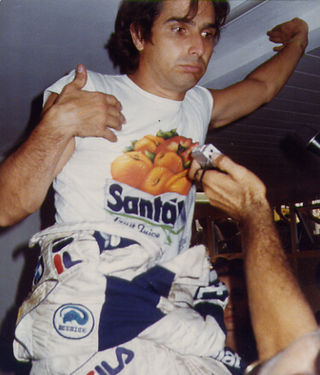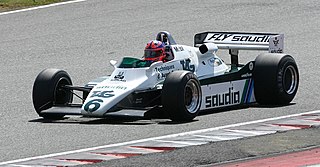
The Formula 3000 International Championship was a motor racing series created by the Fédération Internationale de l'Automobile (FIA) in 1985 to become the final preparatory step for drivers hoping to enter Formula One. Formula Two had become too expensive, and was dominated by works-run cars with factory engines; the hope was that Formula 3000 would offer quicker, cheaper, more open racing. The series began as an open specification, then tyres were standardized from 1986 onwards, followed by engines and chassis in 1996. The series ran annually until 2004, and was replaced in 2005 by the GP2 Series.

BMW has been involved in Formula One in a number of capacities since the inauguration of the World Drivers' Championship in 1950. The company entered occasional races in the 1950s and 1960s, before building the BMW M12/13 inline-four turbocharged engine in the 1980s. This engine was the result of a deal between BMW and Brabham, which resulted in the team's chassis being powered by BMW engines from 1982 until 1987, a period in which Nelson Piquet won the 1983 championship driving a Brabham BT52-BMW. BMW also supplied the M12/13 on a customer basis to the ATS, Arrows, Benetton and Ligier teams during this period, with various degrees of success. In 1988, Brabham temporarily withdrew from the sport and BMW withdrew its official backing from the engines, which were still used by the Arrows team under the Megatron badge. Turbocharged engines were banned by the revised Formula One Technical Regulations for 1989, rendering the M12/13 obsolete.

Formula Two is a type of open-wheel formula racing category first codified in 1948. It was replaced in 1985 by Formula 3000, but revived by the FIA from 2009–2012 in the form of the FIA Formula Two Championship. The name returned again in 2017 when the former GP2 Series became known as the FIA Formula 2 Championship.

The DFV is an internal combustion engine that was originally produced by Cosworth for Formula One motor racing. The name is an abbreviation of Double Four Valve, the engine being a V8 development of the earlier four-cylinder FVA, which had four valves per cylinder.

Thierry Marc Boutsen is a Belgian former racing driver who raced for the Arrows, Benetton, Williams, Ligier and Jordan teams in Formula One. He competed in 164 World Championship Grands Prix, winning three races, achieving 15 podiums and scoring 132 career points. His best finish in the World Drivers' Championship was fourth in 1988 whilst driving for Benetton. He also twice finished second in the 24 Hours of Le Mans sportscar race.

The 1983 Brazilian Grand Prix was a Formula One motor race held at Jacarepaguá on 13 March 1983. It was the first round of the 1983 Formula One season.

The 1984 Monaco Grand Prix was a Formula One motor race held at Monaco on 3 June 1984. It was race 6 of 16 in the 1984 FIA Formula One World Championship. It was the only race of the 1984 championship that was run in wet weather.

The 2002 FIA Formula One World Championship was the 56th season of FIA Formula One motor racing. It featured the 2002 Formula One World Championship for Drivers and the 2002 Formula One World Championship for Constructors, which were contested concurrently over a seventeen-race series that commenced on 3 March and ended on 13 October.

The 1983 FIA Formula One World Championship was the 37th season of FIA Formula One motor racing. It featured the 1983 Formula One World Championship for Drivers and the 1983 Formula One World Championship for Manufacturers, which were contested concurrently over a fifteen-race series that commenced on 13 March and ended on 15 October.

Emilio de Villota Ruíz is a former racing driver from Spain, born in Madrid. He entered 15 Formula One World Championship Grands Prix between 1976 and 1982, qualifying twice. He entered most Spanish Grand Prix between 1976 and 1982 and became a major force in the short-lived Aurora AFX Formula One Championship for F1 cars, winning the title in 1980.

Formula 5000 was an open wheel, single seater auto-racing formula that ran in different series in various regions around the world from 1968 to 1982. It was originally intended as a low-cost series aimed at open-wheel racing cars that no longer fit into any particular formula. The '5000' denomination comes from the maximum 5.0 litre engine capacity allowed in the cars, although many cars ran with smaller engines. Manufacturers included McLaren, Eagle, March, Lola, Lotus, Elfin, Matich and Chevron.
The Atlantic Championship Series is an American open-wheel racing series with races throughout North America. It has previously been called Champ Car Atlantics, Toyota Atlantics, or just Atlantics.

Ralt was a manufacturer of single-seater racing cars, founded by ex-Jack Brabham associate Ron Tauranac after he sold out his interest in Brabham to Bernie Ecclestone. Ron and his brother had built some specials in Australia in the 1950s under the Ralt name. Tauranac won the 1954 NSW Hillclimb Championship in the Ralt 500.

The BMW M12/13 turbo was a 1,499.8 cc four-cylinder turbocharged Formula One engine, based on the standard BMW M10 engine introduced in 1961, and powered the F1 cars of Brabham, Arrows and Benetton. Nelson Piquet won the FIA Formula One Drivers' Championship in 1983 driving a Brabham powered by the BMW M12/13 turbo. It was the first Drivers' Championship to be won using a turbocharged engine. The engine also powered the BMW GTP and in the 2.0-litre naturally-aspirated form, the successful March Engineering Formula Two cars. BMW engineers estimated the engine produced around 1,400 hp at maximum boost, however the BMW engine dynamometer could not go beyond 1,280 bhp.

Bill Alsup was an American race car driver. He was the first Championship Auto Racing Teams (CART) Rookie of the Year in 1979 and competed in the 1981 Indianapolis 500, finishing 11th. He made 57 CART & USAC Champ Car starts in his career. His best race finish of third came 3 times and he was the 1981 CART Championship runner-up, putting in a winless but consistent season for Penske Racing, his only effort with a top-level team. He returned to his own team the next year and struggled until leaving Champ Car following the 1984 Sanair Super Speedway race.

The Tyrrell 012 is a Formula One racing car that was designed by Maurice Philippe for the Tyrrell team. It was introduced for the 1983 season, and was subsequently used in 1984 and the first few races of 1985.

Kaditcha was an automobile manufacturer in Australia. The company, formed by Queensland engineer Barry Lock, made open wheel and sports car racing cars, including cars for Formula 5000, Formula Pacific and Australian Formula 2.

The Arrows A11 was a Formula One car with which the Arrows team competed in the 1989 and 1990 Formula One seasons, and at the start of the 1991 season.

The Williams FW08 was a Formula One car designed by Frank Dernie, which debuted at the 1982 Belgian Grand Prix held at the Zolder circuit. An evolution of the FW07 that it replaced, the car was used by Finnish driver Keke Rosberg to win the 1982 World Drivers' Championship.


















